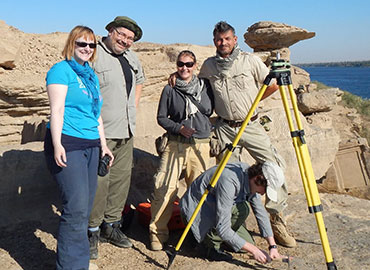|
21/05/2015
MBI Al Jaber Lecture Series: ‘Excavations at Gebel el Silsila, Egypt’ by Dr Sarah Doherty
 |
| Members of the team at the Gebel el Silsila Survey Project |
In her presentation of the ancient site of Gebel el Silsila, Dr. Sarah Doherty discussed the latest season’s work on uncovering ‘the birthplace of ancient Egypt’s temples’. Known to the ancients as Khenu or Kheny, the ancient site of Gebel el Silsila, situated circa 20km downstream from Kom Ombo and 65km north of Aswan, is famous for Egypt’s largest series of sandstone quarries running for c. 2.5 km on both sides of the Nile. Sarah, Archaeologist and Ceramicist for the site, and MBI Al Jaber Foundation and Policy Assistant, talked about how quarried sandstone, chipped away with hammer and chisel, was used to build many temples including those of Luxor and Aswan.
The Gebel el Silsila Survey Project is a multi-disciplinary Swedish project, directed by Dr. Maria Nilsson (Lund University,), who has so far identified 104 quarries at the site. Most of the activity dates from the New Kingdom and Graeco-Roman periods, but there is also evidence to suggest that quarrying took place from Middle Kingdom times.
One of the main aims of the project is to study the pottery at this significant site and its surrounding sub-sites in order to establish a chronology; develop the first pottery typology, and put ‘humans back into the site’ by unpicking the eating, cooking and storage habits of the occupants from the 18th Dynasty until the Early Roman period. Sarah and the Gebel el Silsila team are keen to discover where the quarry workers lived; how they moved around the site; what they ate; where they stored their food, and what sort of activities they engaged in.
Important recent discoveries include a new temple on the northern edge of the site which has been dated to the 18th Dynasty. The finds indicating that this building was a temple include the remains of a Ramses II cartouche; faience beads and scarabs, and legible hieroglyphs. An interesting feature of the temple is that the remains of its column bases are made from sandstone with the inner parts possibly of limestone, indicating a likely date of circa 1500 BC. As well as this evidence, Sarah has examined over 10,000 pottery sherds in order to date the temple – with only 936 useful for the task!
In addition to working at the MBI Al Jaber Foundation and the Gebel el Silsila site, Sarah acts as a Freelance Lecturer for the Egypt Exploration Society (with current course “Ancient Egypt’s Top 10 Technologies”); Secretary for BANEA; Editor of the BFSA Bulletin, and is on the Friends of the Petrie Museum Committee. She completed her PhD at Cardiff University in 2013 focusing on Egyptian ceramics and technology. This has recently been published as The Origins and Use of the Potter's Wheel in Ancient Egypt.
For further information, please contact:
Director Public Relations
[email protected] |


